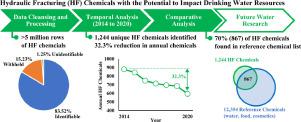Water Research ( IF 12.8 ) Pub Date : 2021-11-19 , DOI: 10.1016/j.watres.2021.117878 Christopher B Hill 1 , Om P Yadav 2 , Eakalak Khan 3

|
Hydraulic fracturing (HF) remains a current global energy policy issue, and understanding risks to drinking water resources from HF chemicals is an important aspect of this topic. The quantity and quality of disclosed HF chemical information are significant barriers for stakeholders attempting to perform systemic environmental and public health research. A repeatable approach for processing HF chemical disclosure data is provided using United States FracFocus data as a case study. We fill research gaps by examining HF chemical trends between 2014 and 2020 and comparing HF chemicals with a list of reference chemicals known or suspected to be in contact (unrelated to HF) with drinking water, food, or cosmetics. In total, 1,244 unique HF chemicals were identified. Compared with EPA's 2016 HF chemical disclosure research, 480 new chemicals are identified, and 318 previously reported chemicals were not observed. The annual unique chemical counts have dropped from 878 to 594 (32.3%) over the research period, while data quality and transparency have increased. Approximately 69.7% of the identified HF ingredients were found in a list of reference chemicals known or suspected to be in contact (unrelated to HF) with drinking water, food, or cosmetics. Chemical differences between production types (gas and oil) and states are also reviewed. Our research reveals that the sociotechnical system surrounding HF is dynamic and moving toward fewer and, in general, safer chemicals, for those that are disclosed. This study highlights opportunities for new and updated systemic research regarding HF chemical hazard dynamics and associated risk to drinking water resources.
中文翻译:

检查水力压裂化学品:时间和比较分析
水力压裂 (HF) 仍然是当前的全球能源政策问题,了解 HF 化学品对饮用水资源的风险是该主题的一个重要方面。公开的 HF 化学信息的数量和质量是利益相关者尝试进行系统环境和公共卫生研究的重大障碍。使用美国 FracFocus 数据作为案例研究,提供了一种处理 HF 化学品披露数据的可重复方法。我们通过检查 2014 年至 2020 年间的 HF 化学趋势并将 HF 化学品与已知或怀疑与饮用水、食品或化妆品接触(与 HF 无关)的参考化学品清单进行比较,从而填补研究空白。总共确定了 1,244 种独特的 HF 化学品。与EPA 2016年HF化学品披露研究相比,确定了 480 种新化学物质,而未观察到 318 种先前报告的化学物质。在研究期间,每年独特的化学物质计数从 878 种下降到 594 种(32.3%),而数据质量和透明度有所提高。在已知或怀疑与饮用水、食品或化妆品接触(与 HF 无关)的参考化学品清单中发现了约 69.7% 的已确定 HF 成分。还审查了生产类型(天然气和石油)和状态之间的化学差异。我们的研究表明,围绕 HF 的社会技术系统是动态的,并朝着更少且通常更安全的化学品方向发展,对于那些已披露的化学品。这项研究强调了关于 HF 化学危害动力学和饮用水资源相关风险的新的和更新的系统研究的机会。318 种以前报告的化学物质没有被观察到。在研究期间,每年独特的化学物质计数从 878 种下降到 594 种(32.3%),而数据质量和透明度有所提高。在已知或怀疑与饮用水、食品或化妆品接触(与 HF 无关)的参考化学品清单中发现了约 69.7% 的已确定 HF 成分。还审查了生产类型(天然气和石油)和状态之间的化学差异。我们的研究表明,围绕 HF 的社会技术系统是动态的,并朝着更少且通常更安全的化学品方向发展,对于那些已披露的化学品。这项研究强调了关于 HF 化学危害动力学和饮用水资源相关风险的新的和更新的系统研究的机会。318 种以前报告的化学物质没有被观察到。在研究期间,每年独特的化学物质计数从 878 种下降到 594 种(32.3%),而数据质量和透明度有所提高。在已知或怀疑与饮用水、食品或化妆品接触(与 HF 无关)的参考化学品清单中发现了约 69.7% 的已确定 HF 成分。还审查了生产类型(天然气和石油)和状态之间的化学差异。我们的研究表明,围绕 HF 的社会技术系统是动态的,并朝着更少且通常更安全的化学品方向发展,对于那些已披露的化学品。这项研究强调了关于 HF 化学危害动力学和饮用水资源相关风险的新的和更新的系统研究的机会。



























 京公网安备 11010802027423号
京公网安备 11010802027423号